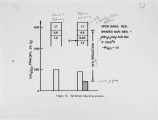| OCR Text |
Show Conversion Efficiency Figure 10 is an experimental examination of the burnout zone chemistry, in particular, the conversion efficiency of NH3 to N2. The rich zone was assumed to supply 600 ppm each of NO and NH3, or an N to NO ratio of 1.0. Under excess air conditions, ammonia gas was mixed with various amounts of CO and injected at temperatures between 1300 and 2200oF. The solid symbols represent the injection of NH3 alone, which is basically a simulation of Thermal De-NOx. For the open symbols, 0.2 percent CO was included with NH3, thereby yielding a burnout-like environment. The presence of CO lowered the optimum temperature for NOx reduction from 18000F to 1500oF. It is readily apparent that a reduction in the burnout temperature from the 2200-2400oF normally employed would increase the conversion efficiency of NH3 + NO to N2 because of the presence of CO. However, it was found that the conversion efficiency was also dependent upon the concentration of CO. As shown in Figure 11, at the optimum reaction temperature of 15000F the optimum CO level was approximately 0.5 percent, or less, equivalent to a rich-zone stoichiometry between 0.95 and 1.0. Figure 12 shows the corresponding results for HCN conversion. Note first that the NO reductions obtained with HCN alone were not as high as those with XH3. Secondly the presence of CO lowered the reduction efficiency. It is obvious that NH3 is the preferred reducing species for the burnout zone. Process Optimization The above results suggest that the key parameters for the enhancement of burnout zone chemistry are: • reaction temperature (15000F), • CO level (0.5% or less), and • NH3 species. 7 |






















